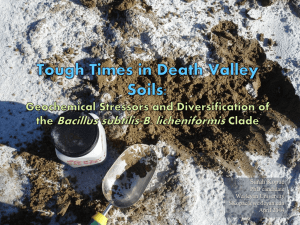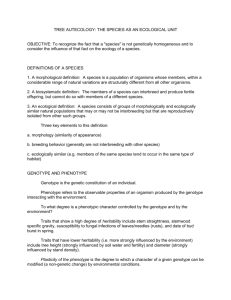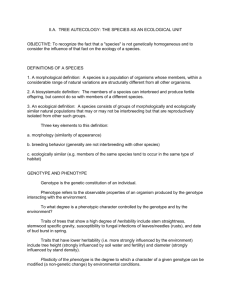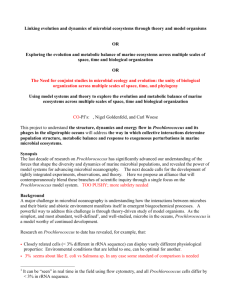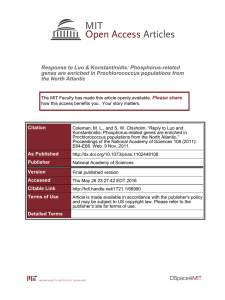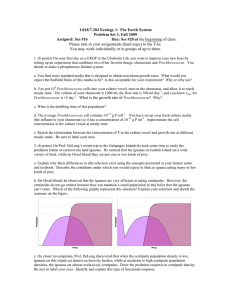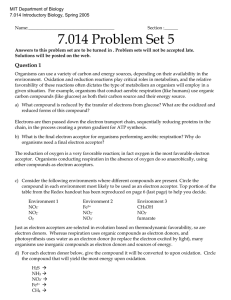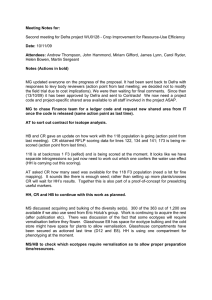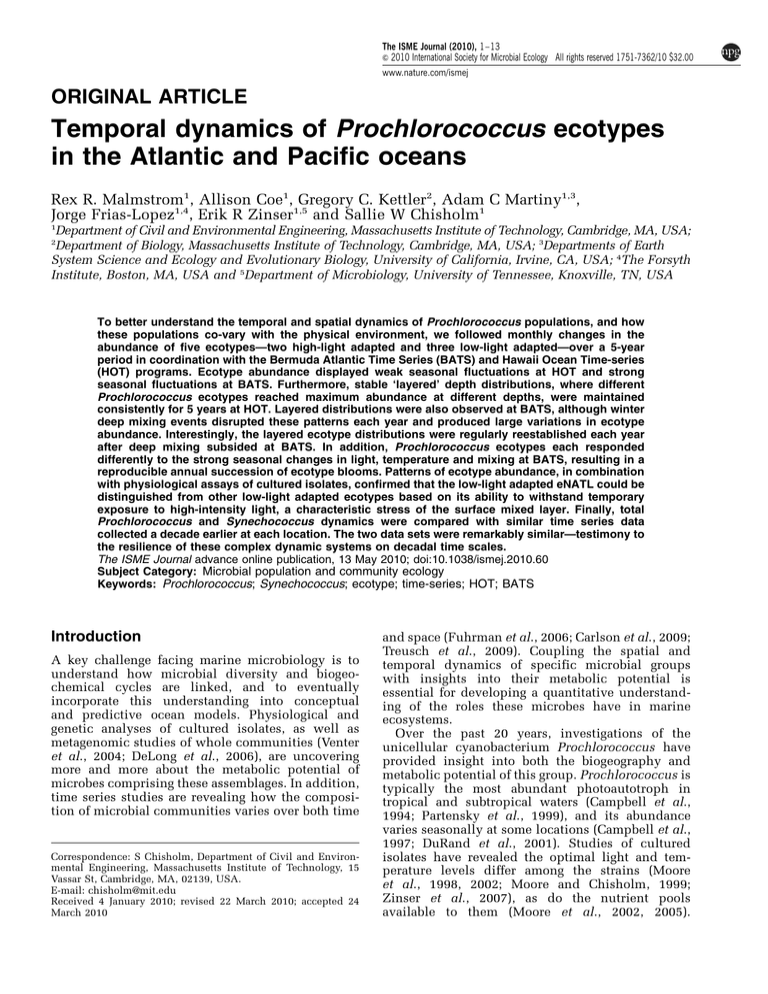
The ISME Journal (2010), 1–13
& 2010 International Society for Microbial Ecology All rights reserved 1751-7362/10 $32.00
www.nature.com/ismej
ORIGINAL ARTICLE
Temporal dynamics of Prochlorococcus ecotypes
in the Atlantic and Pacific oceans
Rex R. Malmstrom1, Allison Coe1, Gregory C. Kettler2, Adam C Martiny1,3,
Jorge Frias-Lopez1,4, Erik R Zinser1,5 and Sallie W Chisholm1
1
Department of Civil and Environmental Engineering, Massachusetts Institute of Technology, Cambridge, MA, USA;
Department of Biology, Massachusetts Institute of Technology, Cambridge, MA, USA; 3Departments of Earth
System Science and Ecology and Evolutionary Biology, University of California, Irvine, CA, USA; 4The Forsyth
Institute, Boston, MA, USA and 5Department of Microbiology, University of Tennessee, Knoxville, TN, USA
2
To better understand the temporal and spatial dynamics of Prochlorococcus populations, and how
these populations co-vary with the physical environment, we followed monthly changes in the
abundance of five ecotypes—two high-light adapted and three low-light adapted—over a 5-year
period in coordination with the Bermuda Atlantic Time Series (BATS) and Hawaii Ocean Time-series
(HOT) programs. Ecotype abundance displayed weak seasonal fluctuations at HOT and strong
seasonal fluctuations at BATS. Furthermore, stable ‘layered’ depth distributions, where different
Prochlorococcus ecotypes reached maximum abundance at different depths, were maintained
consistently for 5 years at HOT. Layered distributions were also observed at BATS, although winter
deep mixing events disrupted these patterns each year and produced large variations in ecotype
abundance. Interestingly, the layered ecotype distributions were regularly reestablished each year
after deep mixing subsided at BATS. In addition, Prochlorococcus ecotypes each responded
differently to the strong seasonal changes in light, temperature and mixing at BATS, resulting in a
reproducible annual succession of ecotype blooms. Patterns of ecotype abundance, in combination
with physiological assays of cultured isolates, confirmed that the low-light adapted eNATL could be
distinguished from other low-light adapted ecotypes based on its ability to withstand temporary
exposure to high-intensity light, a characteristic stress of the surface mixed layer. Finally, total
Prochlorococcus and Synechococcus dynamics were compared with similar time series data
collected a decade earlier at each location. The two data sets were remarkably similar—testimony to
the resilience of these complex dynamic systems on decadal time scales.
The ISME Journal advance online publication, 13 May 2010; doi:10.1038/ismej.2010.60
Subject Category: Microbial population and community ecology
Keywords: Prochlorococcus; Synechococcus; ecotype; time-series; HOT; BATS
Introduction
A key challenge facing marine microbiology is to
understand how microbial diversity and biogeochemical cycles are linked, and to eventually
incorporate this understanding into conceptual
and predictive ocean models. Physiological and
genetic analyses of cultured isolates, as well as
metagenomic studies of whole communities (Venter
et al., 2004; DeLong et al., 2006), are uncovering
more and more about the metabolic potential of
microbes comprising these assemblages. In addition,
time series studies are revealing how the composition of microbial communities varies over both time
Correspondence: S Chisholm, Department of Civil and Environmental Engineering, Massachusetts Institute of Technology, 15
Vassar St, Cambridge, MA, 02139, USA.
E-mail: chisholm@mit.edu
Received 4 January 2010; revised 22 March 2010; accepted 24
March 2010
and space (Fuhrman et al., 2006; Carlson et al., 2009;
Treusch et al., 2009). Coupling the spatial and
temporal dynamics of specific microbial groups
with insights into their metabolic potential is
essential for developing a quantitative understanding of the roles these microbes have in marine
ecosystems.
Over the past 20 years, investigations of the
unicellular cyanobacterium Prochlorococcus have
provided insight into both the biogeography and
metabolic potential of this group. Prochlorococcus is
typically the most abundant photoautotroph in
tropical and subtropical waters (Campbell et al.,
1994; Partensky et al., 1999), and its abundance
varies seasonally at some locations (Campbell et al.,
1997; DuRand et al., 2001). Studies of cultured
isolates have revealed the optimal light and temperature levels differ among the strains (Moore
et al., 1998, 2002; Moore and Chisholm, 1999;
Zinser et al., 2007), as do the nutrient pools
available to them (Moore et al., 2002, 2005).
Temporal Dynamics of Prochlorococcus
RR Malmstrom et al
2
Genomic analyses of isolates (Rocap et al., 2003;
Coleman et al., 2006; Kettler et al., 2007), and
metagenomic analyses of natural communities
(DeLong et al., 2006; Martiny et al., 2006, 2009a),
have provided additional insights into the genetic
diversity, metabolic potential and evolutionary
history of the group. The ability to examine the
abundance and distribution of Prochlorococcus in
the wild, and measure its genomic and metabolic
properties in the lab and field, make Prochlorococcus
a model system for advancing our understanding the
ecology of marine microbes.
Prochlorococcus is composed of several clades
that are physiologically and phylogenetically distinct with respect to their optimal light and
temperature environments (Moore et al., 1998;
Moore and Chisholm, 1999; Rocap et al., 2002;
Johnson et al., 2006; Kettler et al., 2007; Zinser et al.,
2007). These clades have been referred to as
‘ecotypes’ (Moore et al., 1998; Moore and Chisholm,
1999; Rocap et al., 2002) following the broader
historical designation for genetically distinct subgroups within a species that are adapted to specific
environments (Turesson, 1922; Clausen et al., 1940).
They do not necessarily conform to the more recent
and narrowly defined ‘ecotype’ concept developed
by Cohan and others (Cohan, 2001; Cohan and Perry,
2007), which has become a notable model for
exploring the theoretical basis for divergence among
bacteria (Ward et al., 2006; Frasier et al., 2009). A
more detailed discussion of the different uses of the
term ‘ecotype’ is provided by Coleman and
Chisholm, (2007).
The abundance of Prochlorococcus ecotypes in
various oceanic regions has been studied extensively (West and Scanlan, 1999; Ahlgren et al., 2006;
Bouman et al., 2006; Johnson et al., 2006; Zinser
et al., 2006, 2007). Members of the two high-light
adapted (HL) ecotypes, eMIT9312 and eMED4, are
most abundant in the upper regions of the euphotic
zone, whereas low-light adapted (LL) ecotypes such
as eNATL and eMIT9313 are most abundant in the
lower euphotic zone (West et al., 2001; Johnson
et al., 2006; Zinser et al., 2007). These distribution
patterns agree well with differences in the optimal
light levels for representative ecotype strains (Moore
and Chisholm, 1999; Zinser et al., 2007). Furthermore, eMED4 tends to dominate in cooler, higher
latitude waters, whereas eMIT9312 dominates
warmer, lower latitude waters (Johnson et al.,
2006; Zwirglmaier et al., 2007); also in good
agreement with temperature optima of representative strains. Water column stability and nutrient
concentrations have also been correlated with
ecotype abundance (Bouman et al., 2006; Johnson
et al., 2006), and community structure (Martiny
et al., 2009b), although the underlying causalities of
these relationships are not well understood.
The environmental factors influencing Prochlorococcus ecotype abundance, such as light, temperature and water column mixing, vary over time and
The ISME Journal
can display seasonal patterns, thus we might expect
ecotype dynamics to do the same. Although we have
analyzed ecotype variability over a span of a few
days (Zinser et al., 2007), extensive time-series
studies have not been conducted, and thus little is
known about the dynamics of Prochlorococcus
ecotypes on the scale of months to years. Analyses
on these time scales should help refine our understanding of ecotype/environment interactions, and
provide data sets for testing models designed to
explore the dynamics of phytoplankton community
structure (Follows et al., 2007).
To this end, we followed the spatial and temporal
dynamics of Prochlorococcus ecotypes at monthly
intervals over 5 years in coordination with the
Bermuda Atlantic Time Series (BATS) and the
Hawaii Ocean Time-series (HOT) programs (Karl
and Lukas, 1996; Steinberg et al., 2001). Both
programs are focused on oligotrophic, open ocean
sites where Prochlorococcus is found in abundance
(Campbell et al., 1994; DuRand et al., 2001).
However, the physics and chemistry of these
locations differ, most notably by the stronger
seasonal mixing events at BATS and the higher
inorganic phosphate concentrations at HOT
(Wu et al., 2000; Cavender-Bares et al., 2001;
Steinberg et al., 2001). Here, we explore how
changes in environmental factors such as mixing,
light and temperature are related to ecotype abundance and distribution, as well as how they co-vary
temporally over 5 years. We also examine some of
the emergent patterns in the field data through
studies of light-shock tolerance in cultured isolates
of different Prochlorococcus ecotypes.
Materials and methods
Sample collection
Beginning in November 2002, flow cytometry and
qPCR samples were collected over a 5-year period
during monthly cruises for the Bermuda Atlantic
Time Series (BATS) and Hawaii Ocean Time-series
(HOT) programs. Additional samples were collected
bi-weekly between February and April at BATS.
Samples were collected from 12 depths (1, 10, 20,
40, 60, 80, 100, 120, 140, 160, 180 and 200 m) at the
BATS site (B5 nautical mile radius around 311 400 N,
641 100 W), and from 12 depths (5, 25, 45, 60, 75, 85,
100, 115, 125, 150, 175 and 200 m) at Sta. ALOHA
(B5 nautical mile radius around 221 450 N, 1581
000 W). These locations are referred to BATS and
HOT throughout the article for simplicity.
Flow cytometry
Whole seawater samples were immediately fixed
with glutaraldehyde (final conc. 0.125% v/v) for
10 min, frozen in liquid nitrogen, and stored at
!80 1C until samples could be processed in
the laboratory using an influx flow cytometer
Temporal Dynamics of Prochlorococcus
RR Malmstrom et al
3
(Becton Dickinson, Franklin Lakes, NJ, USA). Prochlorococcus and Synechococcus populations were identified and quantified based on their unique
autofluorescence and scatter signals (Olson et al.,
1990a, 1990b). Prochlorococcus could not always be
clearly distinguished in the upper 40 m at BATS from
June–September, thus these profiles were excluded
from depth-integrated counts in Figure 2. Flow
cytometry profiles from early 2003 were not processed.
Primer re-design for ecotype eSS120
New primers for the eSS120 ecotype were designed
in ARB (Ludwig et al., 2004), using a large database
of environmental ITS sequences (Martiny et al.,
2009b). These primers, 50 -AACAAACTTTCTCCTG
GGCT-30 and 50 -AGTTGATCAGTGGAGGTAAG-30 ,
matched 87% of known eSS120 ITS sequences, but
did not target MIT9211. The specificity of the
primers was initially tested against cultured isolates
from other ecotypes such as MIT9313, MIT9312,
MED4 and NATL2a. These tests confirmed specificity within the dynamic range of the assay (B5 to
5 " 105 cells ml!1). Specificity was also confirmed by
cloning and sequencing ITS regions amplified from
field samples from BATS and HOT using the new
primers. All amplified ITS sequences clustered with
strains SS120 and MIT9211, both members of the
eSS120 ecotype (Kettler et al., 2007), in a bootstrapped (n ¼ 100) neighbor-joining tree constructed
with the Bosque software package (Ramirez-Flandes
and Ulloa, 2008) (Supplementary Figure 1). The new
primers substantially increased counts of the SS120
ecotype (Supplementary Materials).
Quantitative PCR
Samples for qPCR were collected and processed as
described previously (Ahlgren et al., 2006; Zinser
et al., 2006, 2007) with two small modifications.
First, reaction volumes were reduced from 25 ml to
15 ml and performed in 384-well plates on the
Light Cycler 480 for samples collected after 2003.
Second, concentrations of eMIT9313-specific primers were increased to 5 mM to improve sensitivity.
Estimated abundances that fell below the lowest
value of the standard curve were set to the
theoretical detection limit of 0.65 cells ml!1. Samples were excluded if their melt curves contained
multiple peaks or peaks different from those in the
DNA standards to ensure only the targeted ecotypes
were quantified. Missing data were determined by
linear interpolation when abundance estimates were
available for the depths immediately above and
below the missing value.
Environmental data extraction
Temperature, salinity and potential density were
downloaded from the HOT and BATS websites.
Missing data were determined by linear interpolation
when values were available for the depths immediately above and below the missing data point. Mixed
layer depths, light attenuation coefficients and
Prochlorococcus and Synechococcus abundance
(1991–1995) were also downloaded directly from
the HOT website. Mixed layer depths and attenuation coefficients at BATS were calculated from
bottle-derived profiles and SeaWiFS Profiling Multichannel Radiometer profiles of photosynthetically
active radiation (PAR) collected by Bermuda BioOptics Program. The mixed layer depth was determined when potential density differed from surface
values by 40.125 kg m!3. Attenuation coefficients at
BATS were calculated by linear regression of logtransformed PAR values; only profiles with an
R240.993 were used.
Solar irradiance
Surface irradiance was determined from SeaWiFSderived estimates of daily-integrated PAR. Eight-day
means of daily integrated PAR values from March
2000 to July 2006 were calculated from a 27 km by
27 km region around BATS and HOT (White et al.,
2007). A two component Fourier model with a
period of 1 year was fitted to PAR data, producing an
R2 of 0.90 and 0.93 at BATS and HOT, respectively.
Modeled PAR data were used to estimate surface
irradiance on the day of sample collection. This
model was necessary to account for seasonal
variability in solar flux due to changes in day
length and solar azimuth. These changes result in
a roughly two-fold difference in daily-integrated
solar flux between summer and winter (for
example, B20 000–56 000 mE m!2 d!1 at BATS,
and B31 000–58 000 mE m!2 d!1 at HOT, using
this model).
The relationships between ecotype abundance
and PAR plotted in Figure 1 and Supplementary
Figure 2 were determined using robust locally
weighted linear regression (LOWESS) in MATLAB.
Robust LOWESS is more resistant to outliers
(Cleveland, 1979), which are defined in MATLAB’s
robust LOWESS function as data outside six mean
absolute deviations.
Time series and other statistical analyses
Integrated ecotype abundance, surface PAR, and
mixed layer depth were log-transformed, detrended,
and resampled at a regular monthly interval to meet
the mathematical requirements for time series
analyses (Legendre and Legendre, 1998). Detrended
data were calculated as the residuals of linear
regression of log-transformed data against time.
Detrended data were resampled every 30.44 days,
which is equivalent to 12 measurements per year,
using linear interpolation. Coefficients of autocorrelation and cross-correlation were determined
in MATLAB, and s.d. calculated as n!1/2, where n is
the number or resampled data points. Spectral
The ISME Journal
Temporal Dynamics of Prochlorococcus
RR Malmstrom et al
4
Figure 1 Ecotype distribution patterns in relation to depth and photosynthetically active radiation (PAR). A smoothed illustration of the
relationship between ecotype abundance and irradiance, calculated from a compilation of data from all 5 years, was plotted for HOT
(a) and BATS (c). Data were smoothed by locally weighted regression of ecotype abundance against irradiance. Smoothed data exclude
profiles with a mixed layer depth 4100 m. Representative depth profiles of ecotype abundance at HOT (b, e) and BATS (d, f) during
periods of stratification and deep mixing. Dashed lines mark the mixed layer depth, and error bars represent one s.d. An illustration of
the color scheme and general phylogenetic relationships among ecotypes after (Rocap et al., 2002; Kettler et al., 2007) is displayed in
(g). This tree serves only as reference to the other panels; branch lengths are not to scale.
analysis by discrete Fourier transformation calculated using the Fast Fourier Transformation (FFT)
algorithm, was also performed in MATLAB. The
power spectral density was estimated as the absolute value of FFT2.
Differences among ecotypes in the average depth
of maximum abundance were tested using repeatedThe ISME Journal
measures ANOVA, followed by a Tukey post-test
(a ¼ 0.05), using MATLAB.
Non-parametric partial correlation coefficients
(Spearman R) were calculated in MATLAB to
determine the relationship between abundance
and temperature while controlling for the influence
of light.
Temporal Dynamics of Prochlorococcus
RR Malmstrom et al
5
Light shock experiments
Serial batch cultures of axenic Prochlorococcus
strains MED4, NATL2a and SS120 were grown in
Sargasso seawater-based Pro99 media (Moore et al.,
2007) and illuminated by cool white fluorescent
lamps. Cultures were transferred at least four times
to acclimatize them to 35 mE m!2 s!1 of continuous
light. Duplicate acclimated cultures that were in logphase growth were then exposed to 400 mE m!2 s!1
for 4 h before being returned to their initial light
levels. In vivo chlorophyll fluorescence was measured before and after light shock with a 10-AU
fluorometer (340–500 nm excitation and 680 nm
emission filters), and cell counts determined by
flow cytometry as described above.
Results and Discussion
Ecotype distribution with light and temperature
Striking similarities between HOT and BATS
emerged when data from all depths and all 5 years
were combined for a synoptic analysis of Prochlorococcus ecotype abundance along irradiance/depth
gradients (Figures 1a and b; Supplementary Figure
2). As expected, the two high-light adapted ecotypes, eMIT9312 and eMED4, were most abundant
at higher irradiances, with abundance dropping off
sharply below 1500 mE m!2 d!1 of photosynthetically active radiation (Figures 1a and b; Supplementary Figures 2a and e). In contrast, two low-light
adapted ecotypes, eSS120 and eMIT9313, usually
reached maximum abundances between 100 and
250 mE m!2 d!1, and were typically at or near detection limits at irradiances 41500 mE m!2 d!1. The
eNATL group, also low-light adapted had an intermediate distribution, reaching maximum abundance
at 300–600 mE m!2 d!1. Unlike the other low light
ecotypes, eNATL abundance was occasionally high
at irradiance levels 41500 mE m!2 d!1 (Figures 1a
and b; Supplementary Figures 2c and h), which is
consistent with hypothesis that eNATL can tolerate
exposure to higher light levels than eSS120 and
eMIT9313 (Coleman and Chisholm, 2007; Zinser
et al., 2007).
This consistent relationship between irradiance
and ecotype abundance results in a ‘layered’0 depth
distribution at both locations (Figures 1a–d). At
HOT, for example, HL ecotype eMIT9312 tended to
reach maximum abundance at shallower depths
than did its fellow HL ecotype eMED4 (Table 1).
LL ecotypes also partitioned the water column at
HOT, with eNATL abundance peaking at significantly shallower depths than eSS120 and eMIT9313
(Table 1). Similar patterns in ecotype distribution
were also observed at BATS (Table 1; Figures 1b
and d), except for during deep mixing events,
defined here as when the mixed layer depth was
4100 m. During periods of deep mixing physical
homogenization appears to overwhelm biological
partitioning of the water column, resulting in
Table 1 Average depth of maximum ecotype abundance at HOT
and BATS (mean±STD)
Ecotype
HOT (m)
BATS (m)
eMIT9312
eMED4
eNATL
eSS120
eMIT9313
42±27A
71±29B
105±18C
118±26D
128±30D
54±28A
60±26A
87±22B
101±28C
107±25C
Samples collected when the mixed layer depth was 4100 m were
excluded. Values with different superscripts are significantly different
(Tukey post test of repeated measures ANOVA; a ¼ 0.05).
uniform depth distributions (Figures 1e and f). Therefore, data from periods of deep mixing were removed
from statistical analysis of depth distributions.
It is remarkable that, with the exception of periods
of deep mixing, the general patterns of ecotype
abundance appear relatively consistent in the
Atlantic and Pacific despite substantial differences
in the chemical and physical environment. Furthermore, these patterns are consistent with those found
previously in a variety of ocean regions (West and
Scanlan, 1999; West et al., 2001; Bouman et al.,
2006; Johnson et al., 2006; Zinser et al., 2006, 2007).
That is, the ecotypes tend to partition the water
column by depth, with eNATL reaching maximum
abundance in between the peaks of HL ecotypes
MED4 and MIT9312, and other LL ecotypes. The
similarities in the distributions along depth/light
gradients suggest that Prochlorococcus ecotypes are
responding in a consistent fashion to irradiance
regardless of geography.
Temporal dynamics: depth-integrated Prochlorococcus
and Synechococcus populations
Using flow cytometry, we measured the abundance of
Prochlorococcus, and its close relative Synechococcus (Rocap et al., 2002), to provide an overall
framework for exploring Prochlorococcus ecotype
dynamics. At BATS, the depth-integrated Prochlorococcus population displayed a strong seasonal pattern, reaching the highest levels in the late summer
and fall, and the lowest in the late winter during the
annual deep mixing events (Figure 2a). Synechococcus
displayed the inverse pattern, and even occasionally
exceeded the abundance of Prochlorococcus during
deep mixing events (Figure 2b). This is the
same pattern reported by DuRand et al, (2001) for
Prochlorococcus and Synechococcus at BATS from
1990 to 1994 (Figures 2a and b). The concordance
between these two data sets is remarkable, given that
they are separated by more than a decade.
Variations in Prochlorococcus and Synechococcus
abundance were much less dramatic at HOT.
Integrated abundance of Prochlorococcus varied just
over 2-fold throughout the time series, and did not
always reach maximal abundance in the summer or
minimal abundance in the winter (Figure 2c).
The ISME Journal
Temporal Dynamics of Prochlorococcus
RR Malmstrom et al
6
Figure 2 Abundance of Prochlorococcus and Synechococcus at BATS and HOT determined by flow cytometry (bottom x axis).
Abundance levels from this study are compared with those collected at BATS from 1990 to 1994 (DuRand et al., 2001) (a, b), and at HOT
from 1991 to 1995 (c, d) (top x axis), which were also determined by flow cytometry.
Synechococcus still displayed an annual pattern,
tending to reach peak abundance during winter, but
they were never as abundant as Prochlorococcus, in
contrast to what was observed at BATS. These
abundance and variability levels are also consistent
with those observed over a decade ago at HOT
(Figures 2c and d)
Temporal dynamics: depth-integrated ecotype
abundance patterns
As was seen in the total Prochlorococcus population, the depth-integrated (0–200 m) abundance of
all five ecotypes followed clear annual patterns at
BATS (Figure 3a). Spectral analysis of each ecotype
revealed dominant peaks in the power spectrum at
a period of 1 year (Supplementay Figure 3), and
autocorrelations displayed a sinusoidal pattern,
with peaks in autocorrelation every 12 months
(Supplementary Figure 4). Furthermore, fitting a
single component Fourier series with a period of 1
year to each ecotype produced R2 values ranging
from 0.48 (eMIT9313) to 0.67 (eSS120), indicating
that most of the variability in integrated abundance
could be accounted for by an annual oscillation.
Annual variations in temperature and mixed layer
depth were smaller at HOT than at BATS, as were
the variations in ecotype abundance (Figure 3b).
Although spectral analysis did reveal that all
ecotypes had a peak in the power spectrum at a
period of 1 year, this was not the only strong signal,
The ISME Journal
Figure 3 Integrated ecotype abundance (0–200 m) at BATS
(a) and HOT (b) from 2003 to 2008. Solid lines represent
abundances smoothed by locally weighted regression for
eMIT9312 (yellow), eMED4 (green), eNATL (blue), eSS120
(purple) and eMIT9313 (red).
Temporal Dynamics of Prochlorococcus
RR Malmstrom et al
7
particularly for the LL ecotypes (Supplementary
Figure 5). Fitting a single component Fourier series
with a period of 1 year to each ecotype produced R2
values ranging from only 0.17 (eMIT9312) to 0.33
(eMIT9313). In addition, autocorrelations did not
display the same strong sinusoidal pattern as seen at
BATS (compare Supplementary Figure 3 with
Supplementary Figure 6). Thus, while there was a
component of annual variability to ecotype abundance at HOT, there was also a variability at periods
greater and less than 1 year. This suggests that when
annual environmental variations are more moderate,
the impact of intra- and inter-annual events, such as
passage of mesoscale eddies or El Niño/La Niña
oscillations—both known to influence primary
production and phytoplankton community composition at HOT (Karl et al., 1995; Letelier et al., 2000;
Corno et al., 2007; Bibby et al., 2008)—may become
more pronounced.
Although ecotype abundance followed a clear
annual cycle at BATS, the cycles were not synchronized among ecotypes, that is, different ecotypes
reached peak abundance at different times. In each
of the 5 years, the eNATL ecotype reached its
maximum integrated abundance about 4 months
after winter deep mixing events (Table 2), typically
in June (Supplementary Figure 7). Abundance of
eMED4 peaked roughly 1 month later, whereas the
LL-clades eSS120 and eMIT9313 reached maximal
abundance about 8 months after the deep mixing
event (Table 2). HL ecotype eMIT9312 also reached
maximal abundances at around the same time as
eSS120 and eMIT9313, typically in October or
November (Supplementary Figure 7). The regularity
of this pattern indicates that each ecotype responded to changes in environmental conditions
in different, yet consistent ways, resulting in an
annually repeating succession of ecotypes.
The succession of Prochlorococcus ecotypes is in
some ways reminiscent of classical phytoplankton
succession models, although it is occurring at a
much smaller phylogenetic scale; all Prochlorococcus
differ in 16S rRNA sequence by o3% (Moore et al.,
1998), which would collectively constitute a single
Table 2 Correlation and cross-correlation between integrated
ecotype abundance (0–200 m) and mixed layer depth at BATS
Ecotype
eMIT9312
eMED4
eNATL
eSS120
eMIT9313
Correlation coeff.
(lag in months)
!0.06
!0.62*
!0.54*
!0.60*
!0.46*
(0)
(0)
(0)
(0)
(0)
Max. cross-correlation
coeff. (lag in months)
0.61*
0.58*
0.65*
0.66*
0.61*
(8)
(5)
(4)
(8)
(8)
The coefficient of cross-correlation represents the relationship
between abundance at 1 month and the mixed layer depth from
previous months. The maximum positive cross-correlation is reported
alongwith the delay in months (lag) between abundance and mixed
layer depth when correlation is greatest. *Indicates Po0.05.
bacterial species by conventional standards (Stackebrandt and Goebel, 1994). Interestingly, two recent
time series studies at BATS have also uncovered
annual cycles and succession patterns in other
microbial groups, most notably the SAR11 clade
(Carlson et al., 2009; Treusch et al., 2009). For
example, one SAR11 subgroup reaches peak abundance in surface waters during the summer, whereas
another subgroup peaks in the winter (Carlson et al.,
2009). SAR11 bacteria are the most abundant
heterotrophs at BATS and are major consumers of
dissolve organic compounds (Morris et al., 2002;
Malmstrom et al., 2005), whereas Prochlorococcus is
the most abundant photoautotroph and a substantial
source of dissolved organics (DuRand et al., 2001;
Bertilsson et al., 2005). In addition, SAR11 bacteria
and Prochlorococcus are both major consumers of
small compounds like amino acids and dimethylsulfoniopropionate (DMSP) (Zubkov et al., 2003;
Malmstrom et al., 2004; Vila-Costa et al., 2006;
Michelou et al., 2007), which are significant sources
of C, N and S to marine microbial communities.
Therefore, it seems plausible that succession in
these two abundant groups could be linked through
the production of, and competition for, dissolved
organic compounds. Uncovering potential links in
the dynamics of the dominant microbial groups
presents a future challenge.
Ecotype abundance in different regions of the
euphotic zone
Variations in light and temperature levels, which
impact the growth of Prochlorococcus (Moore and
Chisholm, 1999; Johnson et al., 2006; Zinser et al.,
2007), are greater in surface waters than at depth.
Thus integrating abundance across the entire water
column likely obscures important features in ecotype dynamics. To get a more detailed understanding of the temporal and spatial dynamics of the
ecotypes, we analyzed integrated abundance in
three sections of the euphotic zone (0–60 m,
60–120 m and 120–200 m).
The HL-adapted ecotype eMIT9312 displayed
similar abundance patterns in the upper (0–60 m)
and middle (60–120 m) euphotic zone at BATS, but
below 120 m the seasonal cycle was out of phase
with surface cycles by several months (Figure 4a;
Figure 5a). Abundance in the lower euphotic was
positively correlated with mixed layer depth
(Spearman R ¼ 0.5; Po0.05), and abundance peaks
occurred simultaneously with annual deep mixing
events (Figure 4a). This suggests that it is the
transport of surface populations below 120 m, and
not in situ growth that may be responsible for most
of the annual variations in abundance of eMIT9312
in the lower euphotic zone at BATS.
As with eMIT9312, patterns of eMED4 abundance
in the upper and middle euphotic zone also differed
from those in the lower zone at BATS (Figure 5b),
with strong spikes in abundance below 120 m
The ISME Journal
Temporal Dynamics of Prochlorococcus
RR Malmstrom et al
8
Figure 4 Ecotype abundance at BATS (a–e) and HOT (f–j) from 2003 to 2008. Sampling depths at HOT and BATS are indicated by the
points overlaying (a and f). The solid lines indicate the mixed layer depth.
accompanying deep mixing (Figure 4b). But while
the eMED4 and eMIT9312 dynamics were synchronized below 120 m, these HL-adapted ecotypes were
out of synchronization by several months in the
upper 120 m (Figures 5a and b). That is, each year at
BATS, eMED4 typically reached peak abundance in
July–August, whereas eMIT9312 reached maximum
abundance in October–November (Supplementary
Figure 7). At HOT, in contrast, these two HL
ecotypes did not display these offset repeating
patterns.
We hypothesize that different temperature sensitivities of eMED4 and eMIT9312 explain, at least in
part, the differences in their temporal dynamics at
BATS. That is, strains belonging to the eMED4 clade
The ISME Journal
have lower temperature optima than those belonging
to the eMIT9312 clade (Johnson et al., 2006; Zinser
et al., 2007). If this differential trait is universal
among cells belonging to the eMED4 and eMIT9313
clades, then this would allow eMED4 cells to
accumulate during the first half of the year when
temperatures were low, whereas the higher temperature optimum of eMIT9312 would limit their
accumulation until later in the season when temperatures were high—as was observed at BATS. In
fact, the abundance of eMED4 in the upper 60 m was
negatively correlated with temperature when light
levels were taken into account (partial correlation
coeff. –0.43; Po0.05), whereas eMIT9312 abundance was positively correlated with temperature
Temporal Dynamics of Prochlorococcus
RR Malmstrom et al
9
Figure 5 Integrated ecotype abundance in different regions of the euphotic zone at BATS (a–e) and HOT (f–j). The regions from 0–60 m,
60–120 m and 120 m are identified by filled squares, open circles and open triangles, respectively. Abundance was smoothed using
locally weighted regression to eliminate low frequency variation.
(partial correlation coeff. 0.30; Po0.05). The potential influence of temperature on the temporal
distribution of HL ecotypes at BATS is analogous
to its inferred influence on their geographic distribution: eMED4 dominates in cooler, higher latitude waters, and eMIT9312 dominates warmer,
lower latitude waters (Johnson et al., 2006; Zwirglmaier et al., 2007).
Abundance patterns of eNATL also differed
among regions of the euphotic zone, and the
similarity of these patterns between BATS and
HOT was striking. At both locations, abundance in
the upper 60 m typically peaked 3–4 months earlier
than at 60–120 m and 120–200 m (Figures 4c and h;
Figures 5c and h). Integrated abundance in the
upper 60 m reached maximum levels during deep
mixing events, and decreased as the mixed layer
depth shoaled (Figures 4c and h). This suggests that
annual peaks in abundance in the upper 60 m were
due, at least in part, to vertical transport of deeper
cells to surface waters via mixing. While it remains
unclear if members of the LL-adapted eNATL clade
were able to grow at high light levels found in the
upper euphotic zone, the net accumulation eNATL
cells throughout the water column during periods of
deep mixing confirmed that the eNATL clade was
able to at least tolerate temporary exposure to high
irradiance.
In contrast to eNATL, the abundance of the other
two LL-adapted ecotypes, eSS120 and eMIT9313,
did not increase dramatically in the upper 60 m
during periods of deep mixing. In fact, their
The ISME Journal
Temporal Dynamics of Prochlorococcus
RR Malmstrom et al
10
abundance was typically near or below detection
levels throughout the entire water column at BATS
when the well-mixed layer spanned the euphotic
zone (Figures 4d and e). It appears that, unlike
eNATL, members of the eSS120 and eMIT9313
ecotypes could not tolerate temporary high light
exposure when transported to surface waters via
mixing. At HOT, however, the mixed layer depth
rarely exceeded 100 m, and therefore a substantial
fraction of eSS120 and eMIT9313 cells were not
transported to surface waters during winter mixing
events. Thus, it appears that eSS120 and eMIT9313
maintained relatively stable abundance levels
throughout the time series, in comparison with
BATS, as they were not subjected to inhibitory, or
lethal, high light exposure during mixing events.
Response to light shock in cultured isolates
To directly test the hypothesis that members of the
eNATL clade can withstand temporary exposure to
high intensity light better than members of the other
LL-ecotypes, we performed light shock experiments
with cultured isolates from the eMED4, eNATL and
eSS120 clades. Strains acclimated to an irradiance
of 35 mE m!2 s!1 were exposed to light levels of
400 mE m!2 s!1 for 4 h and then returned back to
35 mE m!2 s!1. For perspective, these light levels are
equivalent to those that would be found at 90 m and
36 m at mid-day, assuming a surface irradiance of
2000 mE m!2 s!1 and an attenuation coefficient of –
0.045 m!1, which are typical of HOT and BATS.
Furthermore, 400 mE m!2 s!1 is a lethal intensity for
NATL2a and SS120, but not MED4, when applied
continuously (Moore and Chisholm, 1999).
In vivo chlorophyll fluorescence of all three
cultures dropped significantly relative to the control
after the light shock. Fluorescence in MED4
and NATL2a cultures rebounded within 24 h and
continued to increase over the next 48 h (Figure 6),
whereas fluorescence of the SS120 culture contin-
Figure 6 Response of Prochlorococcus strains MED4,
NATL2a and SS120 to light-shock. In vivo chlorophyll fluorescence of duplicate cultures acclimated to 35 mE m!2 s!1, exposed
to 400 mE m!2 s!1 for 4 hours (gray area), and returned to
35 mE m!2 s!1. Controls did not experience light shock. Error bars
represent one s.d.
The ISME Journal
ued to decline for the following 72 h. Cell concentrations of MED4 and NATL2a also rose following
the light shock, whereas the number of SS120 cells
declined throughout the recovery period (Supplementary Figure 8). These results indicate that
NATL2a can withstand temporary light shock better
than SS120, which is consistent with the temporal
and spatial distribution patterns of their respective
ecotypes at HOT and BATS described above. These
results are also consistent with a similar light shock
experiment comparing isolates SS120 and PCC
9511, a member of the HL-adapted eMED4 ecotype.
In this study, the capacity to repair damage to
photosystem II caused by light shock was much
greater in PCC 9511 than in SS120 (Six et al., 2009).
Although it was not tested specifically, it is
plausible that NATL2a is also better able to reverse
photoinactivation of photosystem II than SS120. If
so, then this would present a possible mechanism to
explain, at least in part, the differences in temporary
light shock tolerance and the subsequent environmental distributions of LL ecotypes.
Analysis of the genomes of cultured isolates
provides some insight into the genes that may be
responsible for differences in light physiology among
LL-adapted ecotypes. For example, the two sequenced eNATL isolates each have 41 genes encoding
high light-inducible proteins (HLIP), whereas the
other LL-adapted ecotypes only have 9–13 HLIP
genes (Coleman and Chisholm, 2007). This protein
family, also called small cab-like proteins, aids in
high-light survival and photoacclimation in Synechocystis (He et al., 2001; Havaux et al., 2003), and
may also have a role in light-shock tolerance in
eNATL. The mechanism by which they do this
remains unclear, but high light-inducible proteins
are thought to physically associate with either
photosystem and allow it to shed excess energy as
heat and thereby reduce photoinactivation (Promnares et al., 2006; Yao et al., 2007). As a photosynthetic organism, reducing and reversing the
effects of photosystem inactivation is crucial for
the survival of Prochlorococcus exposed to high
light levels.
Differences in their ability to repair UV-damaged
DNA may also partially explain differences in the
environmental distributions of eNATL and other LL
ecotypes. The six sequenced isolates from the two
HL-adapted ecotypes and the two sequenced isolates from the eNATL ecotype contain genes that
encode photolyase (Coleman and Chisholm, 2007;
Kettler et al., 2007), an enzyme helps repair
UV-damaged DNA (Sancar, 2000). Photolyase
genes are absent in the genomes of the other four
LL-adapted isolates that have been sequenced.
Although these other LL-adapted isolates do encode
for an alternate putative UV-repair enzyme, pyrimidine dimer glycosylase (Goosen and Moolenaar,
2008; Partensky and Garczarek, 2010), its function
in Prochlorococcus has not been confirmed. This
enzyme also has a modification of the Arg-26
Temporal Dynamics of Prochlorococcus
RR Malmstrom et al
residue that is known to dramatically reduce
activity in homologs (Doi et al., 1992; Goosen and
Moolenaar, 2008), suggesting a diminished ability to
repair UV-damaged DNA in eSS120 and eMIT9313
ecotypes. Indeed, the high-light adapted strain
MED4, which encodes photolyase, has a greater
tolerance to UV exposure than low-light adapted
strain MIT9313 (Osburne et al., 2010), which lacks
photolyase but encodes pyrimidine dimmer glycosylase. Thus, the protection from UV exposure
provided by photolyase may explain, at least in
part, why the eNATL clade can better survive
transport to UV-rich surface waters.
11
Acknowledgements
We thank Michael Lomas and the BATS team for sample
collection at Bermuda, and David Karl, Matthew Church,
and the HOT team for sample collection at Hawaii. We
also thank Angel White and Ricardo Letelier for assistance
with deriving solar flux data and attenuation coefficients.
Norm Nelson and David Court generously provided light
data from the Bermuda Bio Optics Program. We thank
Daniele Veneziano for advice on statistical analysis. This
work was funded by grants from the National Science
Foundation, NSF STC Center for Microbial Oceanography:
Research and Education, and the Gordon and Betty Moore
Foundation.
Conclusions
Clear patterns in the temporal and spatial distribution of Prochlorococcus ecotypes emerge from
this study. For example, ecotype abundance follows
a strong annual pattern at BATS, whereas ecotype abundance has only a weak annual pattern at
HOT. In addition, ecotypes at BATS follow an
annual succession pattern, but a similar pattern is
not observed at HOT. These patterns are consistent
with what we have learned from physiological
assays on cultured isolates with regards to the light
optima, temperature optima, and light-shock tolerance of different ecotypes. That is, the distinct
distribution patterns at both HOT and BATS can be
explained, at least in general terms, by the consistent and predictable responses of ecotypes to
changes in the light, temperature and mixing at
each location.
Analyses of inorganic nutrient concentrations and
ecotype abundance were not possible as nutrient
levels were below detection in the upper 100 m at
BATS throughout most of this study. However, while
nutrients undoubtedly influence growth rates and
standing stocks of Prochlorococcus, their influence
on specific ecotypes may not be apparent, as
evidenced by the fact that general patterns can be
explained without them. Indeed, recent work suggests that nitrate concentrations might impact the
composition of Prochlorococcus populations at finer
phylogenetic levels than the ecotypes examined in
our study (Martiny et al., 2009b). Exploring how,
and at which temporal, spatial and phylogenetic
scales, the chemical and biological environment
influence Prochlorococcus abundance and diversity
presents a future challenge.
Results from this study help set the stage for
coupling patterns in temporal and spatial dynamics
of ecotypes with insights into their metabolic
potential. The next step is to understand how
Prochlorococcus ecotypes, or even sub-groups within these ecotypes, might differ in terms of nutrient
usage, dissolved organic matter production and
consumption, and other metabolic processes. This
understanding will come from additional studies
involving strain isolation, metagenomic comparisons, and large-scale single-cell genomics.
References
Ahlgren NA, Rocap G, Chisholm SW. (2006). Measurement of Prochlorococcus ecotypes using real-time
polymerase chain reaction reveals different abundances of genotypes with similar light physiologies.
Environ Microbiol 8: 441–454.
Bertilsson S, Berglund O, Pullin MJ, Chisholm SW. (2005).
Release of dissolved organic matter by Prochlorococcus.
Vie Et Milieu-Life and Environment 55: 225–231.
Bibby TS, Gorbunov MY, Wyman KW, Falkowski PG.
(2008). Photosynthetic community responses to upwelling in mesoscale eddies in the subtropical north
atlantic and pacific oceans. Deep-Sea Res Part II-Top
Stud Oceanogr 55: 1310–1320.
Bouman HA, Ulloa O, Scanlan DJ, Zwirglmaier K, Li WK,
Platt T et al. (2006). Oceanographic basis of the global
surface distribution of Prochlorococcus ecotypes.
Science 312: 918–921.
Campbell L, Liu HB, Nolla HA, Vaulot D. (1997). Annual
variability of phytoplankton and bacteria in the
subtropical north pacific ocean at station ALOHA
during the 1991–1994 ENSO event. Deep-Sea Res Part
I-Oceanogr Res Pap 44: 167.
Campbell L, Nolla HA, Vaulot D. (1994). The importance
of prochlorococcus to community structure in
the central north pacific-ocean. Limnol Oceanogr 39:
954–961.
Carlson CA, Morris R, Parsons R, Treusch AH, Giovannoni SJ,
Vergin K. (2009). Seasonal dynamics of SAR11
populations in the euphotic and mesopelagic zones
of the northwestern Sargasso Sea. ISME J 3: 283–295.
Cavender-Bares KK, Karl DM, Chisholm SW. (2001).
Nutrient gradients in the western north atlantic ocean:
relationship to microbial community structure and
comparison to patterns in the pacific ocean. Deep-Sea
Res Part I-Oceanogr Res Pap 48: 2373–2395.
Clausen J, Keck DD, Hiesey WM. (1940). Experimental
studies on the nature of species. I. Effects of varied
environments on western North American plants.
Carnegie Institute of Washington 520.
Cleveland WS. (1979). Robust locally weighted regression
and smoothing scatterplots. J Am Stat Assoc 74:
829–836.
Coleman ML, Chisholm SW. (2007). Code and context:
Prochlorococcus as a model for cross-scale biology.
Trends Microbiol 15: 398–407.
Coleman ML, Sullivan MB, Martiny AC, Steglich C,
Barry K, Delong EF et al. (2006). Genomic islands
The ISME Journal
Temporal Dynamics of Prochlorococcus
RR Malmstrom et al
12
and the ecology and evolution of Prochlorococcus.
Science 311: 1768–1770.
Cohan FM. (2001). Bacterial species and speciation.
Systematic Biol 50: 513–524.
Cohan FM, Perry EB. (2007). A systematics for discovering
the fundamental units of bacterial diversity. Curr Biol
17: R373–R386.
Corno G, Karl DM, Church MJ, Letelier RM, Lukas R,
Bidigare RR et al. (2007). Impact of climate forcing on
ecosystem processes in the North Pacific Subtropical
Gyre. J Geophys Res 112: C04021, doi:10.1029/
2006JC003730.
Doi T, Recktenwald A, Karaki Y, Kikuchi M, Morikawa K,
Ikehara M et al. (1992). The role of the basic amino
acid cluster and Glu-23 in pyrimidine dimer glycosylase activity of T4-endonuclease-V. Proc Natl Acad
Sci USA 89: 9420–9424.
DeLong EF, Preston CM, Mincer T, Rich V, Hallam SJ,
Frigaard NU et al. (2006). Community genomics
among stratified microbial assemblages in the ocean’s
interior. Science 311: 496–503.
DuRand MD, Olson RJ, Chisholm SW. (2001). Phytoplankton population dynamics at the bermuda atlantic
time-series station in the sargasso sea. Deep-Sea Res
Part II-Top Stud Oceanogr 48: 1983–2003.
Frasier C, Alm EJ, Polz MF, Spratt BG, Hanage WP. (2009).
The bacterial species challenge: making sense of
genetic and ecological diversity. Science 323: 741–746.
Follows MJ, Dutkiewicz S, Grant S, Chisholm SW. (2007).
Emergent biogeography of microbial communities in a
model ocean. Science 315: 1843–1846.
Fuhrman JA, Hewson I, Schwalbach MS, Steele JA, Brown
MV, Naeem S. (2006). Annually reoccurring bacterial
communities are predictable from ocean conditions.
Proc Natl Acad Sci USA 103: 13104–13109.
Goosen N, Moolenaar GF. (2008). Repair of UV damage in
bacteria. DNA Repair 7: 353–379.
Havaux M, Guedeney G, He QF, Grossman AR. (2003).
Elimination of high-light-inducible polypeptides related to eukaryotic chlorophyll a/b-binding proteins
results in aberrant photoacclimation in Synechocystis
PCC6803. Biochimica Et Biophysica Acta-Bioenergetics
1557: 21–33.
He QF, Dolganov N, Bjorkman O, Grossman AR. (2001).
The high light-inducible polypeptides in Synechocystis PCC6803 - Expression and function in high light.
J Biol Chem 276: 306–314.
Johnson ZI, Zinser ER, Coe A, McNulty NP, Woodward
EMS, Chisholm SW. (2006). Niche partitioning among
Prochlorococcus ecotypes along ocean-scale environmental gradients. Science 311: 1737–1740.
Karl DM, Letelier R, Hebel D, Tupas L, Dore J, Christian J
et al. (1995). Ecosystem changes in the north pacific
subtropical gyre attributed to the 1991–92
El-Nino. Nature 373: 230–234.
Karl DM, Lukas R. (1996). The hawaii ocean time-series
(HOT) program: background, rationale and field
implementation. Deep-Sea Res Part II-Top Stud
Oceanogr 43: 129–156.
Kettler GC, Martiny AC, Huang K, Zucker J, Coleman ML,
Rodrigue S et al. (2007). Patterns and implications of
gene gain and loss in the evolution of Prochlorococcus. Plos Genetics 3: 2515–2528.
Legendre P, Legendre L (eds). (1998). Ecological
data series. In: Numerical Ecology: Second
English Addition. Elsevier Science BV: Amsterdam,
pp 637–691.
The ISME Journal
Letelier RM, Karl DM, Abbott MR, Flament P,
Freilich M, Lukas R et al. (2000). Role of late winter
mesoscale events in the biogeochemical variability of the upper water column of the north
pacific subtropical gyre. J Geophysical Res-Oceans
105: 28723–28739.
Ludwig W, Strunk O, Westram R, Richter L, Meier H,
Yadhukumar Buchner A et al. (2004). ARB: a software
environment for sequence data. Nucleic Acids Res 32:
1363–1371.
Malmstrom RR, Cottrell MT, Elifantz H, Kirchman DL.
(2005). Biomass production and dissolved organic
matter assimilation by SAR11 bacteria in the
northwest atlantic ocean. Appl Environ Microbiol 71:
2979–2986.
Malmstrom RR, Kiene RP, Cottrell MT, Kirchman DL.
(2004). Contribution of SAR11 bacteria to dissolved
dimethylsulfoniopropionate and amino acid uptake in
the North Atlantic Ocean. Appl Environ Microbiol 70:
4129–4135.
Martiny AC, Coleman ML, Chisholm SW. (2006). Phosphate acquisition genes in Prochlorococcus ecotypes:
Evidence for genome-wide adaptation. Proc Natl Acad
Sci USA 103: 12552–12557.
Martiny AC, Kathuria S, Berube PM. (2009a). Widespread
metabolic potential for nitrite and nitrate assimilation
among Prochlorococcus ecotypes. Proc Natl Acad Sci
USA 106: 10787–10792.
Martiny AC, Tai APK, Veneziano D, Primeau F, Chisholm
SW. (2009b). Taxonomic resolution, ecotypes and the
biogeography of Prochlorococcus. Environ Microbiol
11: 823–832.
Michelou VK, Cottrell MT, Kirchman DL. (2007). Lightstimulated bacterial production and amino acid
assimilation by cyanobacteria and other microbes in
the north atlantic ocean. Appl Environ Microbiol 73:
5539–5546.
Moore LR, Chisholm SW. (1999). Photophysiology of the
marine cyanobacterium Prochlorococcus: ecotypic
differences among cultured isolates. Limnol Oceanogr
44: 628–638.
Moore LR, Coe A, Zinser ER, Saito MA, Sullivan MB,
Lindell D et al. (2007). Culturing the marine
cyanobacterium Prochlorococcus. Limnol Oceanog 5:
353–362.
Moore LR, Ostrowski M, Scanlan DJ, Feren K, Sweetsir T.
(2005). Ecotypic variation in phosphorus acquisition
mechanisms within marine picocyanobacteria. Aquat
Microb Ecol 39: 257–269.
Moore LR, Post AF, Rocap G, Chisholm SW. (2002).
Utilization of different nitrogen sources by the marine
cyanobacteria Prochlorococcus and Synechococcus.
Limnol Oceanogr 47: 989–996.
Moore LR, Rocap G, Chisholm SW. (1998). Physiology and
molecular phylogeny of coexisting Prochlorococcus
ecotypes. Nature 393: 464–467.
Morris RM, Rappé MS, Connon SA, Vergin KL, Siebold
WA, Carlson CA et al. (2002). SAR11 clade dominates
ocean surface bacterioplankton communities. Nature
420: 806–810.
Olson RJ, Chisholm SW, Zettler ER, Altabet MA, Dusenberry JA. (1990a). Spatial and temporal distributions
of prochlorophyte picoplankton in the north-atlantic
ocean. Deep-Sea Res Part a-Oceanographic Res Papers
37: 1033–1051.
Olson RJ, Chisholm SW, Zettler ER, Armbrust EV. (1990b).
Pigments, size, and distribution of synechococcus
Temporal Dynamics of Prochlorococcus
RR Malmstrom et al
13
in the north-atlantic and pacific oceans. Limnol
Oceanogr 35: 45–58.
Osburne MS, Holmbeck BM, Frias-Lopez J, Steen R,
Huang K, Kelly L et al. (2010). UV hyper-resistance in
Prochlorococcus MED4 results from a single base pair
deletion just upstream of an operon encoding nudix
hydrolase and photolyase. Environ Microbiol
Published Online: 23 March 2010; DOI: 10.1111/
j.1462-2920.2010.02203.x.
Partensky F, Garczarek L. (2010). Prochlorococcus: advantages and limits of minimalism. Annu Rev Marin Sci
Vol. 2 305–331.
Partensky F, Hess WR, Vaulot D. (1999). Prochlorococcus:a
marine photosynthetic prokaryote of global significance. Microbiol Mol Biol Rev 63: 106.
Promnares K, Komenda J, Bumba L, Nebesarova J, Vacha F,
Tichy M. (2006). Cyanobacterial small chlorophyllbinding protein ScpD (HliB) is located on the
periphery of photosystem II in the vicinity of PsbH
and CP47 subunits. J Biol Chem 281: 32705–32713.
Ramirez-Flandes S, Ulloa O. (2008). Bosque: integrated
phylogenetic analysis software. Bioinformatics 24:
2539–2541.
Rocap G, Distel DL, Waterbury JB, Chisholm SW. (2002).
Resolution of Prochlorococcus and Synechococcus
ecotypes by using 16S-23S ribosomal DNA internal
transcribed spacer sequences. Appl Environ Microbiol
68: 1180–1191.
Rocap G, Larimer FW, Lamerdin J, Malfatti S, Chain P,
Ahlgren NA et al. (2003). Genome divergence in two
Prochlorococcus ecotypes reflects oceanic niche differentiation. Nature 424: 1042–1047.
Sancar GB. (2000). Enzymatic photoreactivation: 50 years
and counting. Mutation Res-Fundamental Mol
Mechanisms Mutagenesis 451: 25–37.
Six C, Finkel ZV, Irwin AJ, Campbell DA. (2009). Light
variability illuminates niche-partitioning among
marine picocyanobacteria. PLoS ONE 2: e1341.
Stackebrandt E, Goebel BM. (1994). Taxonomic note: a
place for DNA:DNA reassociation and 16S rRNA
sequence analysis in the present species definition
in bacteriology. Int J Syst Bacteriol 44: 846–849.
Steinberg DK, Carlson CA, Bates NR, Johnson RJ,
Michaels AF, Knap AH. (2001). Overview of the US
JGOFS Bermuda atlantic time-series study (BATS): a
decade-scale look at ocean biology and biogeochemistry. Deep-Sea Res Part II-Top Stud Oceanogr 48:
1405–1447.
Treusch AH, Vergin KL, Finlay LA, Donatz MG, Burton
RM, Carlson CA et al. (2009). Seasonality and vertical
structure of microbial communities in an ocean gyre.
ISME J 3: 1148–1163.
Turesson G. (1922). Species and the variety as ecological
units. Hereditas 3: 100–113.
Venter JC, Remington K, Heidelberg JF, Halpern AL, Rusch D,
Eisen JA et al. (2004). Environmental genome shotgun
sequencing of the sargasso sea. Science 304: 66–74.
Vila-Costa M, Simo R, Harada H, Gasol JM,
Slezak D, Kiene RP. (2006). Dimethylsulfoniopropionate uptake by marine phytoplankton. Science 314:
652–654.
Ward DM, Bateson MM, Ferris MJ, Kühl M, Wieland A,
Koeppel A et al. (2006). Cyanobacterial ecotypes in the
microbial mat community of mushroom spring
(yellowstone national park, wyoming) as species-like
units linking microbial community composition,
structure and function. Philos Trans R Soc London
(Biol) 361: 1997–2008.
West NJ, Scanlan DJ. (1999). Niche-partitioning of Prochlorococcus populations in a stratified water column
in the eastern North Atlantic Ocean. Appl Environ
Microbiol 65: 2585–2591.
West NJ, Schönhuber WA, Fuller NJ, Amann RI, Rippka R,
Post AF et al. (2001). Closely related Prochlorococcus
genotypes show remarkably different depth distributions in two oceanic regions as revealed by in situ
hybridization using 16S rRNA-targeted oligonucleotides. Microbiology 147: 1731–1744.
White AE, Spitz YH, Letelier RM. (2007). What factors are
driving summer phytoplankton blooms in the North
Pacific Subtropical Gyre? J Geophys Res 112: C12006,
doi:10.1029/2007JC004129.
Wu JF, Sunda W, Boyle EA, Karl DM. (2000). Phosphate
depletion in the western north atlantic ocean. Science
289: 759–762.
Yao D, Kieselbach T, Komenda J, Promnares K, Prieto MA,
Tichy M et al. (2007). Localization of the small
CAB-like proteins in photosystem II. J Biol Chem
282: 267–276.
Zinser ER, Coe A, Johnson ZI, Martiny AC, Fuller NJ,
Scanlan DJ et al. (2006). Prochlorococcus ecotype
abundances in the North Atlantic Ocean as revealed
by an improved quantitative PCR method. Appl
Environ Microbiol 72: 723–732.
Zinser ER, Johnson ZI, Coe A, Karaca E, Veneziano D,
Chisholm SW. (2007). Influence of light and
temperature on Prochlorococcus ecotype distributions
in the Atlantic Ocean. Limnol Oceanogr 52:
2205–2220.
Zubkov MV, Fuchs BM, Tarran GA, Burkill PH, Amann R.
(2003). High rate of uptake of organic nitrogen
compounds by Prochlorococcus cyanobacteria as a
key to their dominance in oligotrophic oceanic waters.
Appl Environ Microbiol 69: 1299–1304.
Zwirglmaier K, Heywood JL, Chamberlain K, Woodward
EMS, Zubkov MV, Scanlan DJ. (2007). Basin-scale
distribution patters of picocyanobacterial lineages in
the Atlantic Ocean. Environ Microbiol 9: 1278–1290.
Supplementary Information accompanies the paper on The ISME Journal website (http://www.nature.com/ismej)
The ISME Journal

